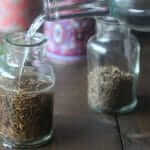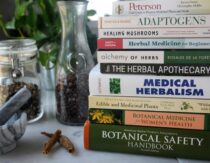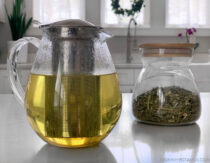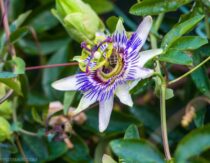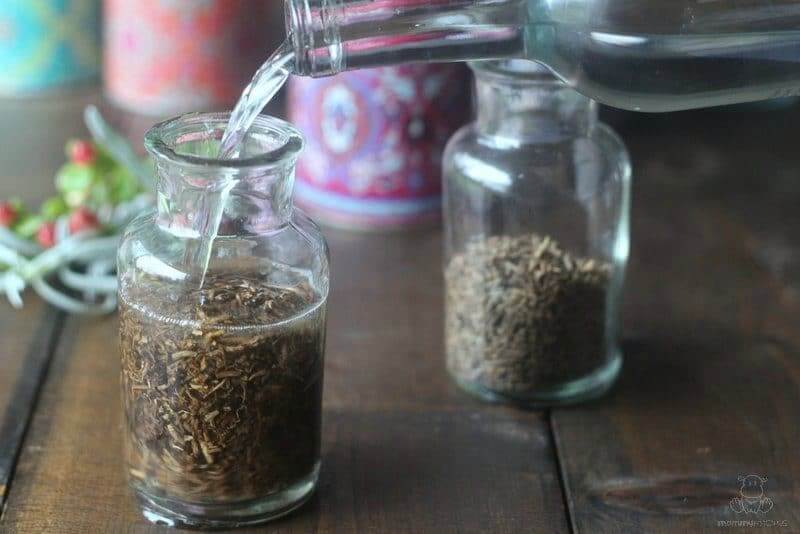
When the Latin word for an herb – valere – literally translates as “to be well,” it kind of grabs your attention, right? For thousands of years, valerian root (valere in Latin) has been relied upon to support emotional well-being, healing sleep, muscle relaxation, stress relief and more.
In fact, during World War II, England’s Vegetable Drug Committee listed valerian root (Valeriana officinalis) as one of the most essential plants for collection because it was so helpful for relieving stress from air raids. (1) (2)
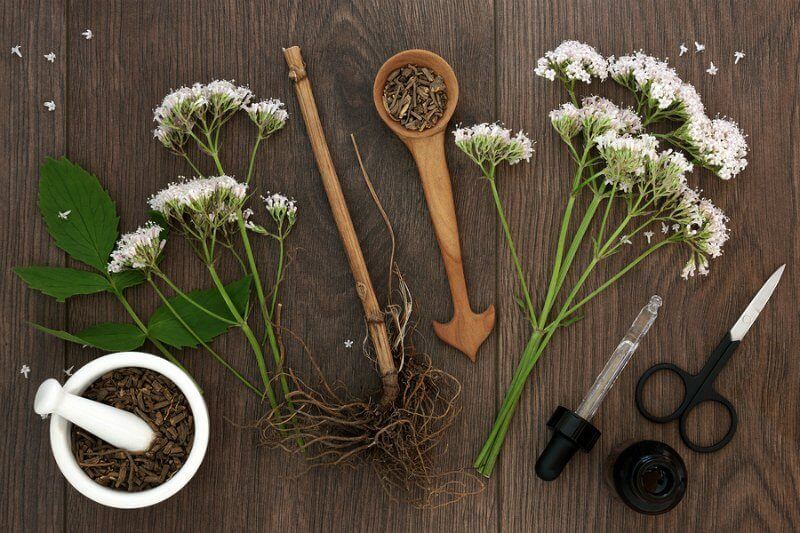
What is Valerian Root? ^
Valerian is a lace-like flowering herb that is native to Asia and Europe, but was brought to North America for therapeutic use.
Although its sweet smelling flowers have sometimes been used for perfume making, the roots and rhizome (underground stalk) are the parts that are used therapeutically. They’re not used for perfume, though, because they smell a little like sweaty socks.
As you can imagine, that’s not really a good thing in anyone’s book, so the popularity of valerian despite this downside speaks to how therapeutic it is.
Before we dive into the details, I want to mention that none of these statements have been evaluated by the FDA, this article is not medical advice, and it is not meant to diagnose or treat any condition. As always, please talk with your healthcare provider about any herbs you are considering. Now that we’ve got that out of the way, let’s take a look at the benefits.
- What is Valerian Root?
- 6 Valerian Root Benefits
- 1. Deeper, Longer Sleep
- 2. Stress Support
- 3. Muscle Relaxation
- 4. May Support Focus, Memory & Learning
- 5. Easing Menstrual Cramps
- 6. Easing Digestive Discomfort
- Choosing Between Valerian Tea, Tincture & Capsules
- Valerian Root Tincture Recipe + Benefits
- Valerian Tea Recipe + Benefits
- Frequently Asked Questions
- Valerian Tea Recipe
6 Valerian Root Benefits ^
Valerian root contains several powerful bioactive compounds that have relaxing, sleep promoting, digestion supporting and other benefits.
The list of known beneficial compounds has been growing over the past few years so there may still be some that are still undiscovered, but here are the most significant ones we know of so far:
- Sesquiterpenes of the volatile oils such as valerenic acid
- Iridoids such as valepotriates
- Alkaloids, which “are perhaps the most potent group of plant constituents that act upon the human body and mind” according to renowned herbalist David Hoffman. (3)
- Linerin and lignan 4 (more on these later)
- Free amino acids such as γ-aminobutyric acid (GABA), tyrosine, arginine, and glutamine (4)
Together, these compounds work synergistically to calm the central nervous system, relax muscles, and more.
1. Deeper, Longer Sleep ^
Research suggests that valerian may help with falling asleep, improving overall sleep quality, and increasing the amount of slow-wave sleep (deep sleep) that we get. (5)(6)
Valerenic acid – which is a component of valerian root – has a positive impact on GABA, which is one of the main sedative neurotransmitters. It’s associated with improved mood, a sense of calm and tranquility, improved sleep, help with PMS, and calm focus. (7) (8) (9) (10)
Low GABA levels have been associated with difficulty unwinding, becoming easily frustrated, feeling overwhelmed, and bowel issues. (11) The conversion of serotonin to melatonin, which is often called “The Sleep Hormone,” is dependent on GABA. (12)
Other supplements that may be helpful for supporting GABA are:
- Magnesium is also helpful for activating GABA receptors, which increases our ability to utilize this relaxing neurotransmitter.
- Passionflower
- Lavender
- Chamomile
- L-theanine
- Kava
- Although not a supplement, fermented foods are also helpful for increasing GABA because they produce it in the gut as a byproduct of amino acid metabolization
Also, coffee lovers check this out: Coffee works by binding with adenosine receptors in the brain, which control the body’s sleeping and waking rhythms.
Adenosine is considered a “tiredness molecule” that lets us know when we need to rest, and coffee blocks it from being absorbed. A specific lignan – called Lignan 4 – in valerian root also binds with the same receptors, but has the opposite effect of coffee. (13)
Valerian also contains the antioxidant linarin, which appears to have calming and sleep-enhancing properties. (14)
2. Stress Support ^
Remember how I told you that England prioritized the cultivation of valerian during WWII? That’s because it’s thought to help with both psychological and physical stress in two ways:
Supporting GABA Levels
A stressful lifestyle, poor sleep, and other challenging experiences can cause us to burn through our GABA stores quickly. Ideally we’d get a break to replenish levels of this calming neurotransmitter before we encounter the next life challenge, but that doesn’t always happen.
Although we know valerian has a positive impact on GABA levels, we’re still figuring out exactly how it works. One theory is that it helps our bodies slow down the rate at which we break GABA down, thus helping us keep more of what we already have. (15)
Maintaining Serotonin & Norepinephrine
One study found that valerian reduced stress in mice by helping maintain serotonin and norepinephrine in two specific brain regions that are associated with fear and anxiousness – the hippocampus and amygdala. The presence of these two neurotransmitters helps to calm excessive activity in the hippocampus/amygdala. (16)
Another study (which was done by many of the same researchers) found that mice who were given valerian had reduced corticosterone levels, which is the mouse version of cortisol (often known as the “Stress Hormone). (17)
Of course, while sipping valerian tea – or taking it in tincture form – can be incredibly helpful during stressful times, there’s more we can do to increase our stress resilience. Here are some of my top tips:
- Incorporate adaptogens, which are herbs that help the body adapt to stress
- Focus on getting good quality sleep
- Gentle exercise, such as walking or yoga
Click here for more ways to reboot your stress response.
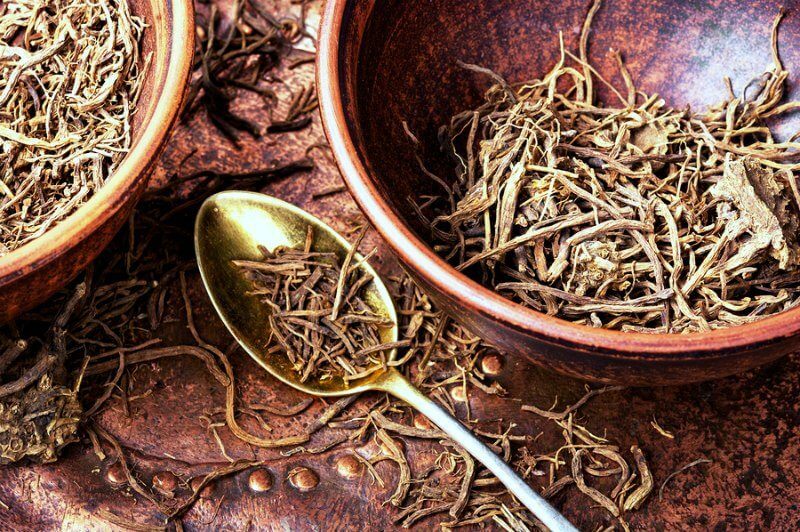
3. Muscle Relaxation ^
According to Aviva Romm, M.D., who is also a midwife and herbalist, valerian root “has been used for musculoskeletal tension for at least 2000 years.” (4)
David Hoffman, FNIMH, AHG, author of Medical Herbalism, agrees, calling it “a valuable muscle relaxant.”
Although there isn’t a lot of modern research available on this particular subject, one animal study did find that valerian extract relaxed skeletal muscles without negatively impacting endurance or neuromuscular tone.
4. May Support Focus, Memory & Learning ^
In one study done with elementary children, a combination of valerian and lemon balm supported focused attention, while another study done with mice showed a positive impact memory and learning. (17)(18)
More studies are needed to clarify the potential benefits of valerian on focus, memory and learning.
5. Easing Menstrual Cramps ^
“Studies show that it works by relaxing the smooth muscles of the uterus,” making it an excellent herb or easing menstrual discomfort. (19)
In one such study, participants who received valerian root felt significantly better than participants who received a placebo.
Note: Cramp bark – either in tincture or capsule form – is sometimes recommended for use alongside valerian root to ease menstrual discomfort. (3)
The two herbs are thought to work synergistically, meaning that they may have an exponentially more powerful effect when used together than either would separately. Herbal synergy is sometimes described as the 2+2=5 effect.
6. Easing Digestive Discomfort ^
Just like it works on the smooth muscle of the uterus, valerian is also thought to relax the smooth muscle of the colon. (19)
Herbalist David Hoffman classifies it as a carminative, or herb that helps with intestinal gas. Carminatives “are rich in volatile oils and, by their action, stimulate the peristalsis of the digestive system and relax the stomach, thereby supporting digestion and helping against gas in the digestive tract.” (3)
Choosing Between Valerian Tea, Tincture & Capsules ^
There are benefits to both approaches. I dive deeper into the different types of herbal preparations and their. benefits/drawbacks in this article, but here’s the short version:
Valerian Root Tincture Recipe + Benefits ^
When it comes to roots and berries, many of the beneficial compounds are better extracted by alcohol than water. That’s probably why most of the valerian root preparations in the studies above are alcohol-based extracts, which are commonly known as tinctures.
There is one component of valerian root – glutamine – that is better extracted by water than alcohol. Glutamine is a building block used to make GABA. There are several ways that valerian supports GABA signaling, and glutamine is just one of them.
In Medical Herbalism, David Hoffman writes that “To be effective, valerian must be used at a sufficiently high dosage.” He recommends a 1:5 tincture (this is a ratio of herb to alcohol) with the alcohol being at least 120 proof (60% alcohol).
Here’s how to make a 1:5 tincture.
Ingredients
- 1 ounce dried valerian root (by weight)
- 5 ounces of 120 proof or higher alcohol (by volume)
To Make
- Add 1 ounce of dried valerian root (by weight) to a 16 ounce jar. Pour the alcohol over the valerian root, then cover the with a lid and shake it well. If desired, write the start date on the jar using a sticky note, label, or piece of tape – it makes keeping track of how long it’s been steeping easier.
- Place the jar in a dark, room temperature area. (I keep mine in a kitchen cabinet.) Let the mixture steep for 3-5 more weeks. Shake occasionally.
- When it’s ready, strain the mixture through a cheesecloth, making sure to squeeze out as much liquid as possible. Pour the tincture in a clean jar or dropper bottle and store it in a cool, dark area.
To Use
Hoffman recommends giving 1/2 to 1 teaspoon in a single dose, but says up to 2 teaspoons may be given at a time. According to a report from the National Institutes of Health (NIH), the 1:5 tincture concentration is often used once to several times per day as needed. (21)
Valerian Tea Recipe + Benefits ^
Teas can be made more quickly, but as mentioned above certain beneficial compounds are not easily extracted with water. However, valerian root tea will have higher levels of glutamine, which is a building block of GABA.
Although many roots are boiled for 30-45 minutes to increase the extraction of precious compounds, with valerian we take a different approach in order to preserve its volatile oils.
Before you brew, one thing to know is that while very helpful for relaxation, valerian root is considered to have an unpleasant smell. I don’t mind it, but you may prefer it in tincture form.
Ingredients
- 1 teaspoon valerian root
- 1 cup water
Instructions
Bring water to a light simmer (not a boil) and pour over the valerian root. Cover the container so that the volatile oils are retained. A small plate works well as a cover. Let the tea infuse for 30 minutes, then strain out the root and serve.
What about valerian root capsules?
Some valerian root capsules contain an extract of one or two “active constituents” rather than the whole root. Since valerian root has several known active constituents (and probably more that we have not yet discovered), I prefer to tinctures and teas that extract a wider range of constituents from the plant.
Some capsules do incorporate the whole root, but when herbs are taken as a capsule the body needs considerably more time to break down and assimilate the nutrients. If digestion is weak, sometimes not all the therapeutic properties will be absorbed.
So what’s the best extraction approach with valerian root? As I mentioned, there are benefits to both tincture and tea forms, so I’ve included recipes for both below.
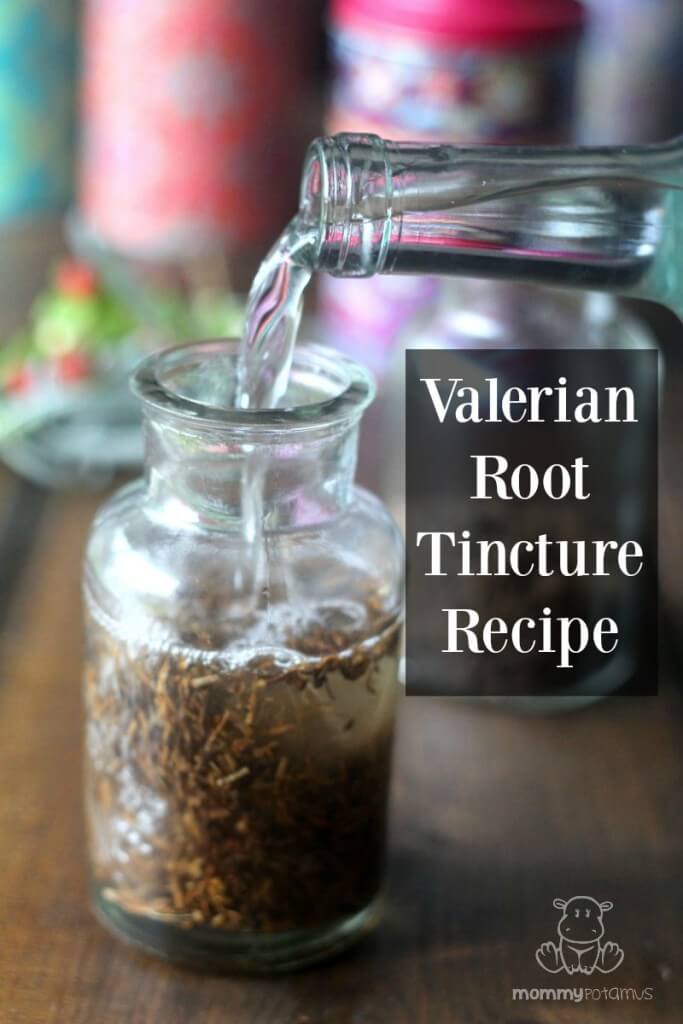
Frequently Asked Questions ^
Below are answers to the most common questions I’ve received about valerian root (and other herb) over the years:
Is valerian root safe?
According to the Botanical Safety Handbook: 2nd Edition, valerian root is a Safety Class 1B herb. This category is described as:
“Herbs that can be safely consumed when used appropriately.
- History of safe traditional use
- No case reports of significant adverse events
with high probability of causality - No significant adverse events in clinical trials
- No identified concerns for use during pregnancy
or lactation (There are split opinions on safety, see note below) - No innately toxic constituents
- Toxicity associated with excessive use is not a
basis for exclusion from this class - Minor or self-limiting side effects are not bases
for exclusion from this class”
However, there are some things to keep in mind.
- Vivid dreams are the most common side effect reported. (4)
- “Caution is advised during use of barbiturates, bensodiazepines, and other sedative drugs,” because valerian may increase their effects. (20)
- “Avoid taking large doses of valerian for an extended period of time; instead, use modest doses for just 2 to 3 weeks, with a week’s break before you begin taking the doses again.” (19)
- Also, for a small percentage of the population, valerian root has a stimulating effect rather than a calming one. According to renowned herbalist Rosemary Gladstar:
The root is rich in isovalerenic and velerenic acids, which give it powerful nerving properties. However, some people are unable to process these two acids, and for them, rather than being relaxing, the herb will agitate and over-stimulate. You’ll know the first time you try it. If you happen to be one of the people for whom valerian is contraindicated, not to worry. The fact that your body can’t convert the isovalerenic and valerenic acids doesn’t mean there’s something wrong with you, only that valerian is not your cup of tea!” (19)
What about pregnancy and breastfeeding?
According to the Botanical Safety Handbook: 2nd Edition, “Animal studies and human case reports have indicated no adverse effects of relatively high doses (2.8g/kg) of valerian in pregnancy.”
However, although no studies have identified concerns for valerian during pregnancy, Aviva Romm classifies it as contraindicated in pregnancy due to the “lack of demonstrated safety and the mutagenic potential of valepotriates, although the actual valepotriate content of commercial products have been found to be extremely low.” (4)
I would err on the side of caution and avoid it.
Regarding breastfeeding, “No information on the safety of valerian during lactation was identified in the scientific or traditional literature. While this review did not identify any concerns for use while nursing, safety has not been conclusively established.” (20)
Can children take valerian root?
When my kids find it difficult to wind down, I tend to opt for milder herbs like the ones in these bedtime tinctures or sweet dreams tea.
That said, one of the studies on focus mentioned above specifically looked at the benefits of valerian for school-age children, and valerian is generally considered safe for kids over 1 when used in age-appropriate amounts.
I like Herbs for Kids Super Calm, which incorporates valerian root with milder herbs and is specifically intended for children. They include dosage information based on age/weight on the bottle.
How much valerian root is recommended?
According to renowned herbalist Rosemary Gladstar, valerian root “is a nonaddictive, non-habit-forming sedative, and it will not make you sleepy or groggy unless really large amounts are consumed. So don’t be afraid to take adequate amounts of valerian.
Begin with a low dosage and increase it until you feel its relaxing effects. You’ll know you’ve taken too much if you have a ‘rubberlike’ feeling in the muscles – as if they were too relaxed – or a feeling of heaviness. If that’s the case, cut back the [amount] so that you feel relaxed but alert.” (21)
She recommends starting with 1/4 teaspoon of the tincture form, then taking a second dose in 30 minutes if needed. However, herbalist David Hoffman says it needs to be used at a “sufficiently high dosage” and recommends starting with 1/2-1 teaspoon.
For tea, the general recommendation is 2-3 grams (about 1 teaspoon) of dried, sifted herb per 8 ounces of water, taken one to several times daily. (4)
Can valerian root be taken long-term?
According to Rosemary Gladstar, it’s important to “Avoid taking large doses of valerian for an extended period of time; instead, use modest doses for just 2 to 3 weeks, with a week’s break before you begin taking the doses again.” (19)
However, according to the Mayo Clinic, “Valerian seems to be most effective after you take it regularly for two or more weeks,” so it seems like around two weeks may be the sweet spot.
Some experts recommend taking valerian for 2-3 weeks, followed by a break of the same duration. I take this approach and rotate valerian root with passionflower.
Valerian Tea Recipe ^
Ingredients
- 1 tsp valerian root
- 1 cup water
Instructions
- Bring water to a light simmer (not a boil) and pour over the valerian root.
- Cover the container so that the volatile oils are retained and let the tea infuse for 30 minutes. A small plate works well as a cover.
- Strain out the root and serve.
Notes
This article was medically reviewed by Dr. Scott Soerries, MD, Family Physician and Medical Director of SteadyMD. As always, this is not personal medical advice and we recommend that you talk with your doctor.
Want more research-backed natural remedies?
No problem, I’ve created a free ebook for you – Kitchen Apothecary: 25+ Natural Remedies Using Ingredients From Your Pantry – as a gift for signing up for my newsletter. You’ll also get updates when I post about safe essential oils for pregnant/breastfeeding mamas, exclusive gifts and coupons (I was able to give away a jar of free coconut oil to anyone who wanted it recently!), plus other goodies.
Sign up using the form below.
Sources for this article:
1. The Herbal Academy (2014) Sheltering With Valerian
2. Tibrewal, Nidhi et. al. (2013) Functional Identification of Valerena-1,10-diene Synthase, a Terpene Synthase Catalyzing a Unique Chemical Cascade in the Biosynthesis of Biologically Active Sesquiterpenes in Valeriana officinalis
3. Hoffman, David (2016) The Complete Herbs Sourcebook
4. Romm, Aviva (2009) Botanical Medicine for Women’s Health
5. Leathwood, PD et. al. (1982) Aqueous extract of valerian root (Valeriana officinalis L.) improves sleep quality in man
6. Donath, F et. al. (2000) Critical evaluation of the effect of valerian extract on sleep structure and sleep quality
7. Kapalka, George. (2009) Nutritional and Herbal Therapies for Children and Adolescents: A Handbook for Mental Health Clinicians (Practical Resources for the Mental Health Professional)
8. Swanson, CJ et. al. (2005) Metabotropic glutamate receptors as novel targets for anxiety and stress disorders
9. Cavadas, C. et. al. (1995) In vitro study on the interaction of Valeriana officinalis L. extracts and their amino acids on GABAA receptor in rat brain
10. WebMD. GABA (Gamma-Aminobutyric Acid)
11. Breus, Michael (2019) Three Amazing Benefits of GABA
12. Balemans, MG et. al. (1983) The influence of GABA on the synthesis of N-acetylserotonin, melatonin, O-acetyl-5-hydroxytryptophol and O-acetyl-5-methoxytryptophol in the pineal gland of the male Wistar rat
13. University of Bonn (2004) Relaxing with Lignan
14. Fernández, Sebastián et. al. (2004) Sedative and sleep-enhancing properties of linarin, a flavonoid-isolated from Valeriana officinalis
15. Wilson, Rose (2017) Does valerian root treat anxiety and insomnia?
16. Jung, HY et. al. (2015) Valerenic Acid Protects Against Physical and Psychological Stress by Reducing the Turnover of Serotonin and Norepinephrine in Mouse Hippocampus-Amygdala Region
17. Nam, SM et. al. (2013) Valeriana officinalis extract and its main component, valerenic acid, ameliorate D-galactose-induced reductions in memory, cell proliferation, and neuroblast differentiation by reducing corticosterone levels and lipid peroxidation
18. Gromball, J. (2014) Hyperactivity, concentration difficulties and impulsiveness improve during seven weeks’ treatment with valerian root and lemon balm extracts in primary school children
19. Gladstar, Rosemary (2012) Rosemary Gladstar’s Medicinal Herbs
20. Gardner, Zoe and McGuffin, Michael (2013) Botanical Safety Handbook: 2nd Edition
21. National Institutes of Health (2009) Valerian (Valeriana officinalis L.)
22. Mayo Clinic (2018) Valerian: A safe and effective herbal sleep aid?

